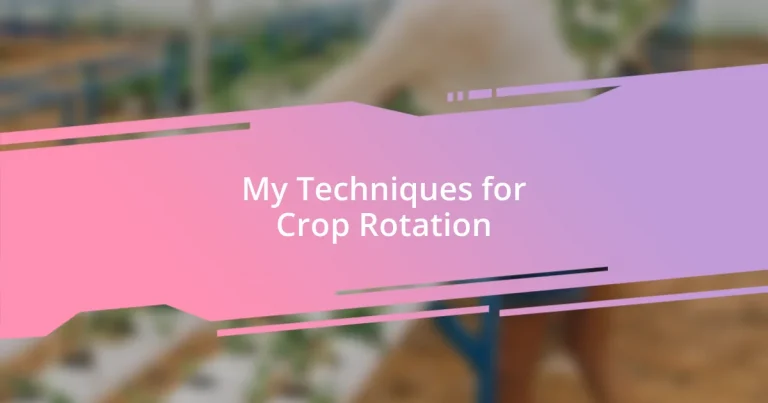Key takeaways:
- Crop rotation is essential for soil health, pest and disease reduction, and improved biodiversity in gardening practices.
- Effective crop rotation principles include understanding crop needs, following plant families, managing soil nutrients, and ensuring proper seasonal timing.
- Adapting crop rotations to local conditions, such as weather patterns and soil types, enhances resilience and productivity in gardening.
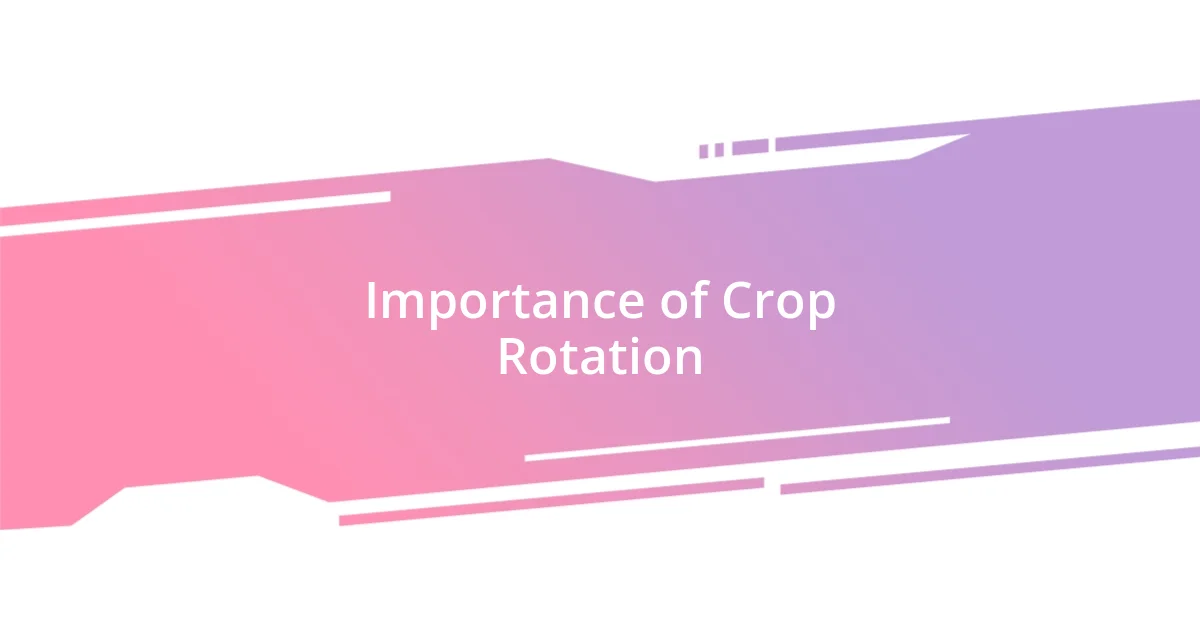
Importance of Crop Rotation
Crop rotation is crucial for maintaining soil health. From my experience, rotating different crops helps prevent soil nutrient depletion. I remember a time when I neglected this practice, and the yield of my tomatoes suffered drastically. It was a wake-up call that showed me how vital it is to give the soil a break.
Moreover, rotating crops significantly reduces pests and diseases. I once planted the same crop in the same spot for two years, and the infestation of aphids was overwhelming. After I decided to mix things up, I noticed a remarkable difference. Have you ever considered how a simple change like this can lead to a healthier garden?
Finally, crop rotation can improve biodiversity in your farming system. I find it exhilarating to see how different plants can attract various beneficial insects, fostering a more vibrant ecosystem. When we embrace this technique, aren’t we taking steps toward not just our own productivity, but also the overall health of the environment?
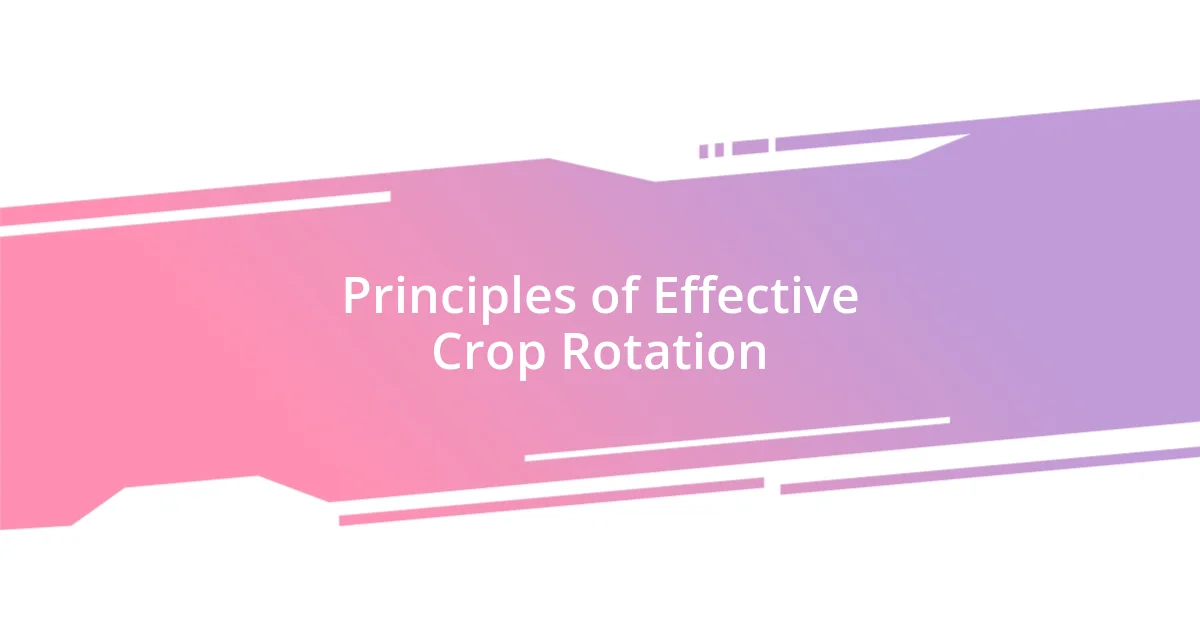
Principles of Effective Crop Rotation
When implementing effective crop rotation, I’ve learned that understanding the specific needs of each crop is key. For instance, legumes enrich the soil with nitrogen, which benefits subsequent crops. I remember experimenting with this; after sowing peas one year, the following season, my corn flourished like never before. It was a gratifying moment, revealing how nature has its own balance when we work with it.
Here are some principles I follow for successful crop rotation:
- Compatibility: Choose crops with complementary needs and benefits, such as rotating deep-rooted plants with shallow-rooted ones.
- Follow Plant Families: Utilize different plant families each season to minimize pest and disease buildup.
- Soil Nutrient Management: Consider the nutrient requirements of each crop, ensuring that rotation supports replenishing soil nutrients rather than depleting them.
- Seasonal Timing: Plan crop rotation based on seasonal growing cycles to optimize yield and crop health.
These principles have consistently guided my approach, making every season a new opportunity to enhance my garden’s productivity and resilience.

Techniques for Planning Rotations
Planning crop rotations can genuinely transform your gardening experience. One technique I often utilize is the “three-year rotation plan.” This approach helps me keep track of what has been planted, ensuring I don’t sow the same crop in the same area too soon. The excitement of watching my plots flourish season after season is fulfilling. I remember vividly the year I implemented this—my kale, which typically struggled, thrived magnificently after I rotated it with legumes.
Another method that has proven effective is the “intercropping” technique. By planting two or more crops in proximity, I can enhance pest control and optimize space. Just last summer, I planted basil alongside my tomatoes, and not only did it elevate the flavor of the tomatoes, but it also kept those pesky whiteflies away. It’s rewarding to see how nature can be so symbiotic when the right companions are chosen. Have you ever thought about the unexpected relationships in your garden?
Lastly, I focus on soil health through cover crops. When I allow a section to rest, I often plant clover or vetch as cover crops. This not only protects the soil from erosion but adds valuable nutrients back into the ground. Witnessing the lush greenery of a cover crop and then realizing it enhances my soil’s vitality is a revelation. It’s like a little secret I’ve discovered—one that whispers the promise of a vibrant garden in the seasons to come.
| Technique | Description |
|---|---|
| Three-Year Rotation | Rotating crops every three years to prevent nutrient depletion and enhance soil health. |
| Intercropping | Planting different crops in close proximity to boost pest control and use garden space efficiently. |
| Cover Crops | Using plants like clover to restore nutrients and protect soil when not in active cultivation. |

Selecting Suitable Crop Combinations
When selecting suitable crop combinations, I often reflect on the balance of nutrient needs each plant brings to the table. For example, I’ve found that pairing root vegetables like carrots with leafy greens such as lettuce works wonders. The greens benefit from the space created by the roots, while the roots enjoy the shade, which keeps them cool in warmer months. Have you ever tried a similar pairing? The results can be surprising!
Another consideration I prioritize is pest management through diversity. The first time I planted marigolds alongside my peppers, I was skeptical. However, those golden blooms seemed to create a protective barrier against nematodes and aphids. It was an unexpected yet delightful revelation that showed me how a little color can lead to a thriving harvest. When you think about it, isn’t it fascinating how plants can help each other survive?
I also pay close attention to the seasonal cycles and how certain crops perform at different times of the year. One year, I grew squash after a batch of early peas. I was amazed at how the squash not only thrived but also benefited from the residual nitrogen left in the soil. Seeing that lush growth reinforced my belief in the interconnectedness of cropping choices. How have you seen nature’s rhythm play out in your own garden?
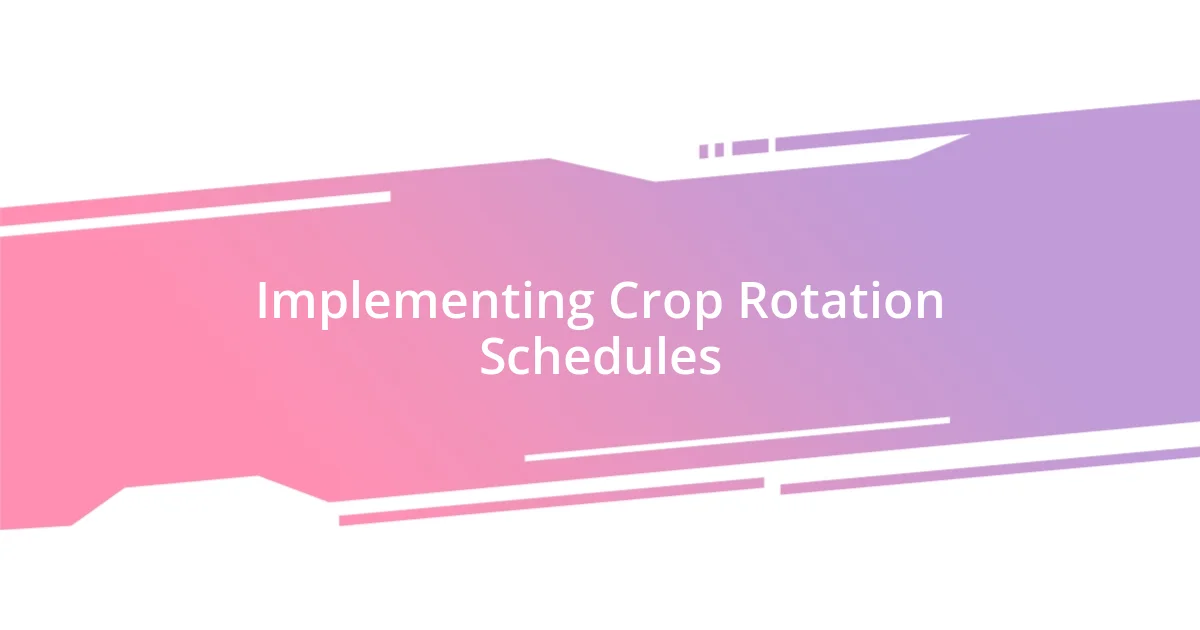
Implementing Crop Rotation Schedules
Implementing a crop rotation schedule can be both strategic and rewarding. I often start by marking a calendar with specific planting dates and which crops will occupy each plot. This simple practice helps me visualize the entire season, preventing me from making the mistake of planting the same type of crop in the same spot too soon. It’s like crafting a garden story, where every chapter has its unique characters.
One strategy I’ve embraced is the “follow-the-leader” approach—after legumes like beans enrich the soil, I plant heavy feeders like corn. That combination never fails to amaze me; seeing the corn tower above the previous year’s leafy greens feels like watching a story unfold in my backyard. Have you ever felt that rush of excitement seeing how one crop can pave the way for another?
I also incorporate flexibility into my rotation schedules. If a pest problem emerges unexpectedly, I adjust my plans on the fly. Last season, I noticed aphids attacking my peppers earlier than anticipated. By quickly switching to a different plot and planting broccoli, I not only salvaged my season but discovered a new love for that cruciferous veggie. Isn’t it fascinating how adapting our plans allows us to turn challenges into delightful surprises?
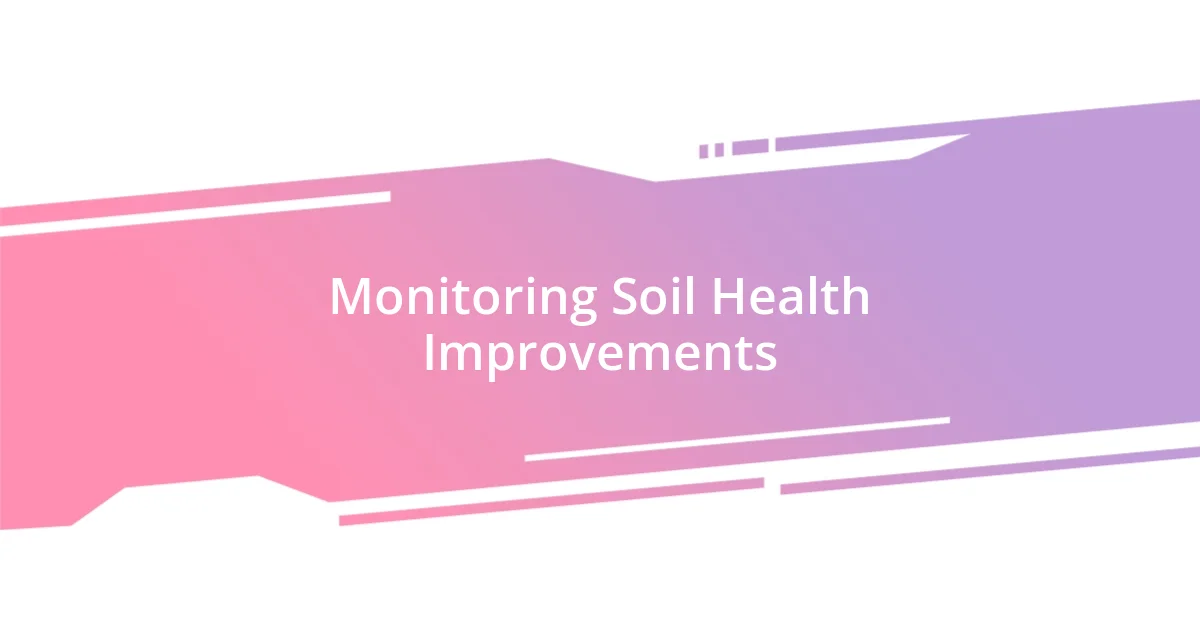
Monitoring Soil Health Improvements
Monitoring soil health improvements is an ongoing journey that I truly enjoy. I’ve come to realize that I must consistently check soil structure and moisture levels after each crop rotation. One summer, I dug up a handful of soil and noticed how crumbly and dark it had become after just two seasons of rotating my crops. It felt like a victory, confirming that my techniques were nurturing the soil’s vitality. What are the signs you look for to gauge your soil’s health?
I also make it a point to use soil testing kits periodically. I remember the first time I tested my soil’s nutrient levels; the results surprised me! It showed that certain nutrients were lacking, leading me to adjust my crop selections for the next season. This proactive approach not only enriched my soil but also deepened my connection to the land. Have you considered how soil testing could enhance your understanding of your garden?
Furthermore, observing earthworm activity has become a reliable indicator of soil health for me. I vividly recall opening my compost pile to find a writhing mass of worms. Their presence not only thrilled me but also assured me that my soil was rich in organic matter. It’s beautiful to witness how each element—microbes, worms, and plants—plays its part in this ecosystem. Isn’t it rewarding to see nature working collaboratively right in our backyards?

Adapting Rotations for Local Conditions
Adapting crop rotations for local conditions requires a keen eye on what the environment offers. I remember one dry summer when I noticed my usual rotation was struggling due to insufficient rainfall. Rather than cling to my plan, I opted for drought-resistant varieties like millet and sorghum. It was a wake-up call that sometimes, nature knows best, and being flexible can lead to unexpected triumphs.
Weather patterns and local pests also play a crucial role in my decision-making. For instance, after a particularly wet spring, I found my squash plagued with mildew. Instead of planting my beloved zucchinis in the same spot, I pivoted to planting sweet potatoes, which thrive in warmer conditions. The adaptability I nurtured over the years not only kept my garden productive but also sparked joy in trying new crops. Have you ever had to shift your plans because of local weather anomalies? It can be a lesson in resilience.
Soil types can significantly influence how I approach rotation. On my sandy plot, I’ve discovered that heavy feeders like tomatoes thrive better with a companion crop that enhances soil moisture retention. I once paired them with a cover crop like clover, and watching this partnership flourish was like witnessing a dance between two different rhythms. It made me realize that understanding the unique traits of my land can guide my choices in monumental ways. How does your soil shape your gardening adventures?












